Imagine the feeling of walking into an exam room, completely confident and prepared. That's the power of a well-crafted study guide. As we delve into the art and science of making study guides, we will uncover examples and templates that can serve as your compass in the sea of knowledge. Here, we will explore how to make a study guide using Boardmix, providing you with examples and templates to optimize your study sessions.
What is a Study Guide?
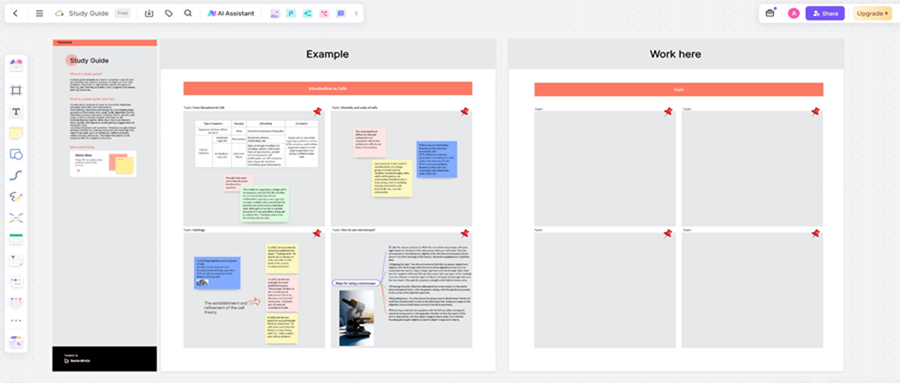
A study guide is a comprehensive learning tool designed to supplement and enhance a student's understanding of academic material. It typically contains a detailed overview of topics covered in a course or textbook, and serves as a roadmap to help students navigate complex information, break down broad topics into manageable segments, and focus on the most important aspects of what they need to learn.
Key Components of a Study Guide:
1. Overview of Topics
This provides a clear and concise summary of each topic or chapter that is being studied. It allows you to quickly review the main points and gain a broad understanding of the subject matter.
2. Detailed Explanations
The guide delves deeper into each topic, providing comprehensive explanations that build on the overview. This could include key definitions, important principles, formulas, diagrams, or examples to illustrate concepts more clearly.
3. Review Questions
Most study guides include review questions or exercises at the end of each section to reinforce learning. These questions are typically designed to mimic the type of questions you might encounter in an exam or test.
4. Answers and Solutions
Alongside the review questions, answers or solutions are usually provided. This allows you to check your understanding and ensure that you're on the right track.
5. Additional Resources
Many study guides also include references to additional resources like textbooks, research papers, online resources, etc., for further exploration of the topics.
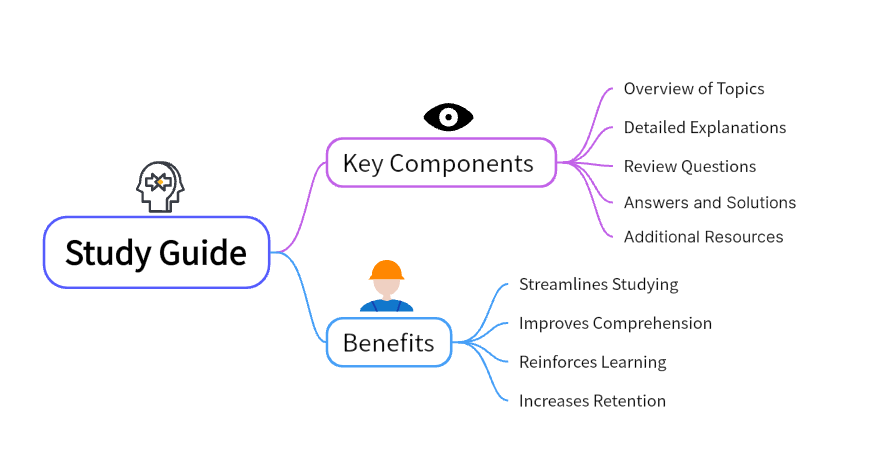
Benefits of Using a Study Guide:
Streamlines Studying: By organizing information into a structured format, study guides help make studying more efficient and less overwhelming.
Improves Comprehension: The detailed explanations in study guides can enhance your understanding of complex concepts.
Reinforces Learning: The practice questions in study guides provide an opportunity to apply what you've learned and reinforce your knowledge.
Increases Retention: By breaking down information into manageable segments, study guides can help improve memory retention.
A study guide is an indispensable tool in the learning process. Whether you're preparing for an exam, trying to understand a complex concept, or just looking to improve your knowledge on a particular subject, a well-prepared study guide can greatly enhance your learning experience.
Online Study Guide Tool with Template
Boardmix provides an interactive and customizable platform that can be used to create dynamic study guides. Here are a few benefits of using Boardmix for this purpose.
1. User-Friendly Interface
Boardmix’s platform is intuitive and easy to navigate, which makes it a great tool for creating comprehensive study guides quickly and effortlessly.
2. Customizable Templates
Boardmix offers customizable templates that you can use as a starting point for your study guides. You can easily add, modify or delete elements as per your needs.
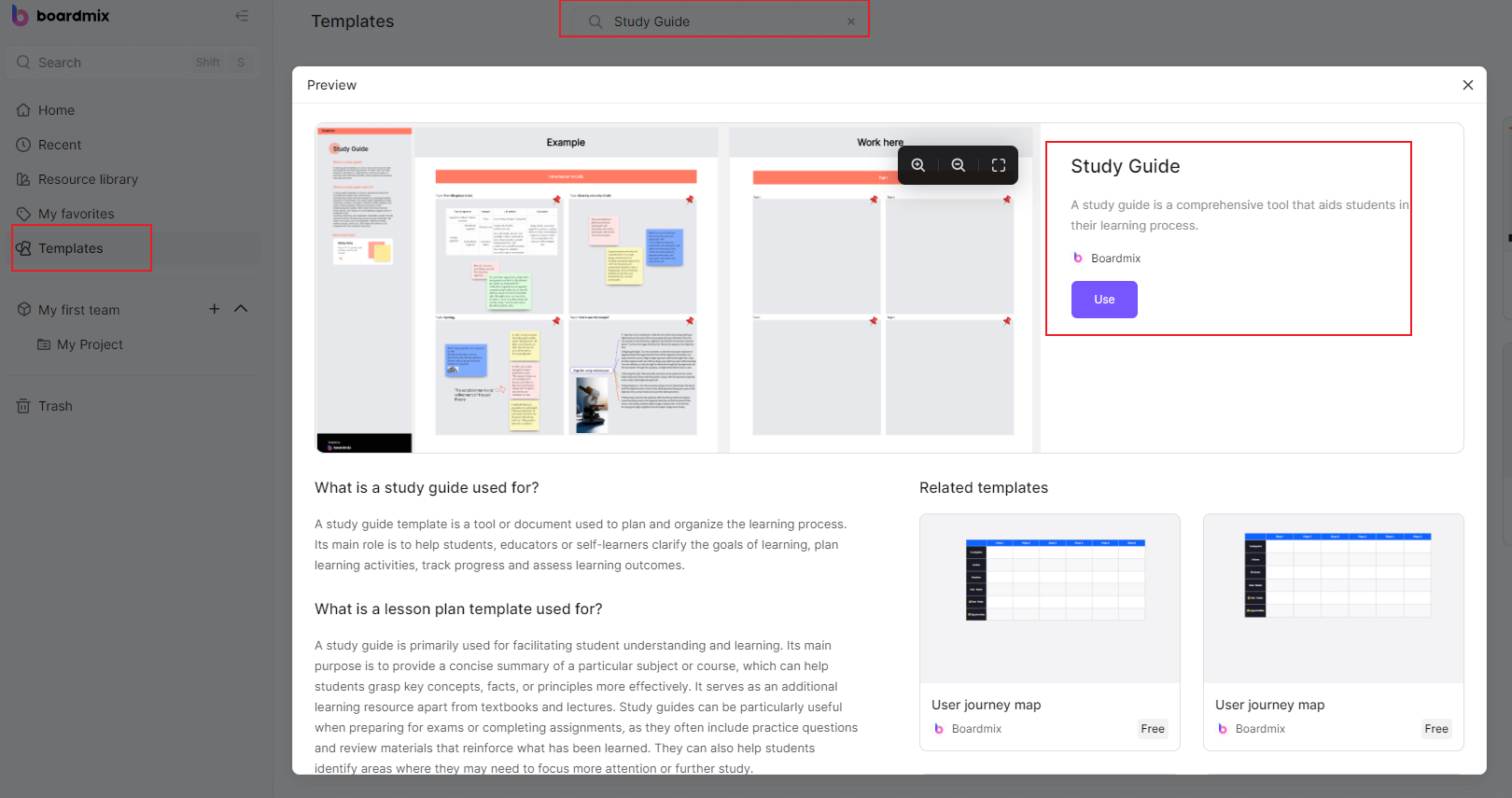
3. Cloud-Based Accessibility
As a cloud-based platform, Boardmix allows you to access your study guides from any device, at any time, giving you the flexibility to study whenever and wherever you choose.
4. Real-Time Collaboration
If you’re studying in a group, Boardmix's real-time collaboration feature is particularly useful. Multiple users can access and modify the same study guide simultaneously, allowing for collective input and shared learning.

5. Integration Capabilities
Boardmix integrates seamlessly with other platforms like Google Drive or Trello. This feature helps keep all your study materials in one place, ensuring a smoother study flow.
How to Make a Study Guide Using Boardmix
Before creating your study guide, clearly define what you want to achieve from your study session. Whether it's understanding a specific concept or preparing for an exam, having clear objectives will help guide your study process. Once you make it, follow these steps to create your study guide with ease.
1. Sign up or login: Login to your Boardmix account online. If you don’t have it yet, sign up with an email for free.

2. Choose a Template: Once log in to your Boardmix account, select a template that suits your needs. There are numerous templates available on Boardmix, including mind maps, concept maps, timelines, and more.

3. Customize Your Template: Once you've chosen a template, start customizing it based on your study objectives. Add sections or cards for different topics or concepts. If you're studying for an exam, you might want to divide your content based on the exam's structure or key areas of focus.
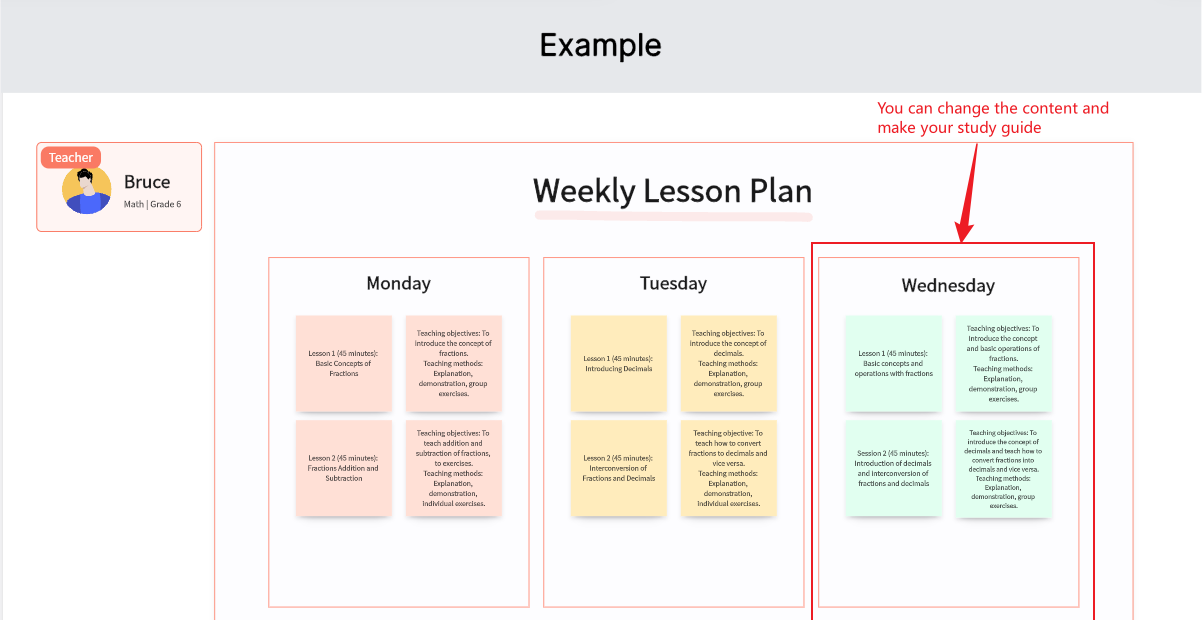
4. Add Detailed Information: Once you have set up your sections or cards, start adding detailed information. This could include definitions, key points, formulas, diagrams, or anything else relevant to your study material.
5. Use Visual Elements: Use images, charts, or colors to differentiate between various topics or concepts. This will make your study guide example more visually appealing and easier to remember.
6. Review and Refine: Regularly review and update your study guide as you progress through your study materials. Remove unnecessary information and add new details as required.
7. Study: Now that you have your study guide ready, start studying! Use the guide as a roadmap to navigate through your study material. Periodically review the guide to reinforce the information in your memory.
8. Collaborate (Optional): If you're studying with others, invite them to collaborate on your study guide. This will allow for a diverse range of inputs and shared learning.

5 Study Guide Examples and Templates
Creating an effective study guide is an art in itself. A well-crafted study guide can greatly enhance your learning process, making studying more efficient and enjoyable. With Boardmix, creating an interactive and comprehensive study guide becomes an easy task. Here are some examples of how you can use Boardmix to create various types of study guides.
1. Concept Map Study Guide Template

A concept map is a visual tool that represents the relationships between concepts. This type of study guide is great for visual learners and can help in understanding complex topics.
How to Create:
- Start with a central concept and then branch out into related sub-concepts.
- Use arrows or lines to show the relationships between different concepts.
- Add details or definitions to each concept card.
Example:
For instance, if you're studying biology and want to understand the human respiratory system, start with "Respiratory System" as your central concept. Then branch out to sub-concepts like "Trachea," "Bronchi," "Lungs," etc., and add details for each.
2. Mind Map Study Guide Template

A mind map is similar to a concept map but less structured. It's used for brainstorming and exploring new ideas.
How to Create:
- Start with a central topic and then add branches for different ideas or sub-topics.
- Use colors, images, and symbols to make the map more engaging and easier to remember.
Example:
For example, if you're brainstorming for an essay about climate change, your central topic could be "Climate Change". Your branches could include "Causes", "Effects", "Solutions", etc.
3. Flashcards Study Guide Template
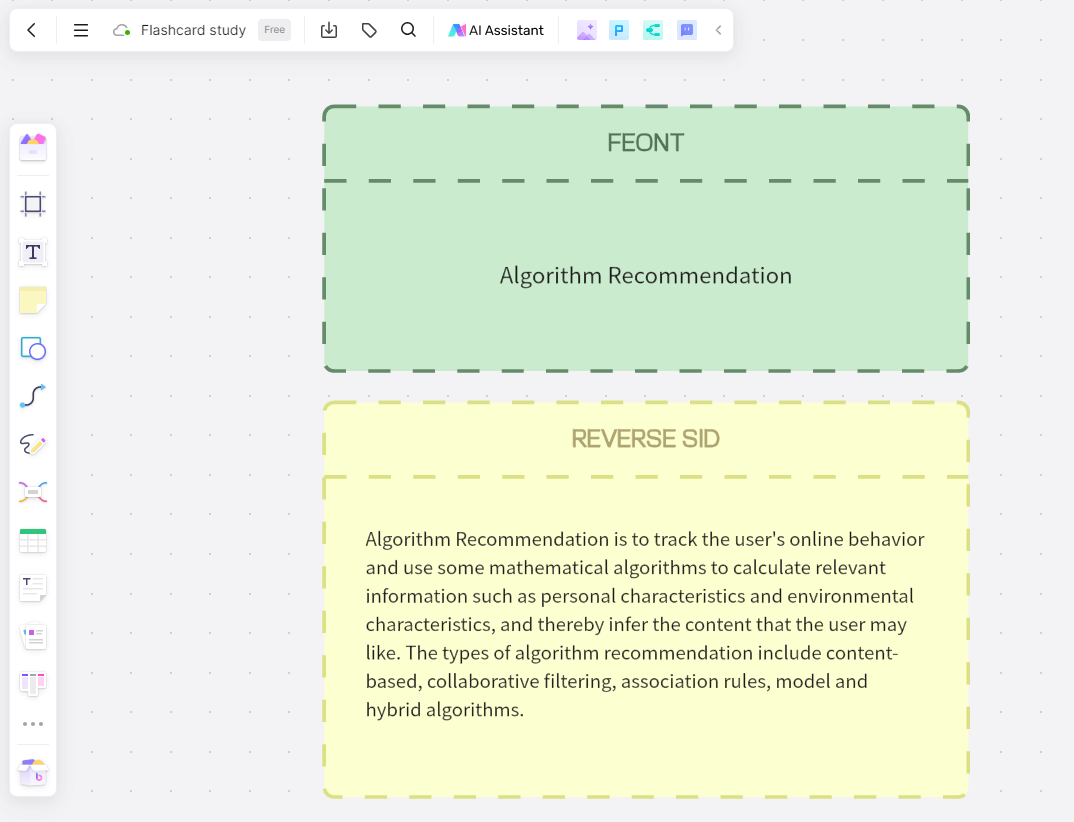
Flashcards are great for memorization. They can be used for studying formulas, definitions, dates, and other factual information.
How to Create:
- On one side of the card, write a question or prompt.
- On the other side, write the answer or information related to the prompt.
Example:
If you're studying Spanish vocabulary, one side of your flashcard could have the English word "Apple", and the other side would have the Spanish translation "Manzana".
4. Timeline Study Guide Template

A timeline is useful for understanding events in chronological order, such as historical events or stages of development.
How to Create:
- Start from the earliest point on the left and work your way to the right with more recent events.
- Add dates and brief descriptions for each event on your timeline.
Example:
For instance, if you're studying World War II, you could start with the event "Hitler becomes chancellor of Germany" in 1933 and end with "Japan surrenders" in 1945.
5. Comparison Chart Study Guide Template
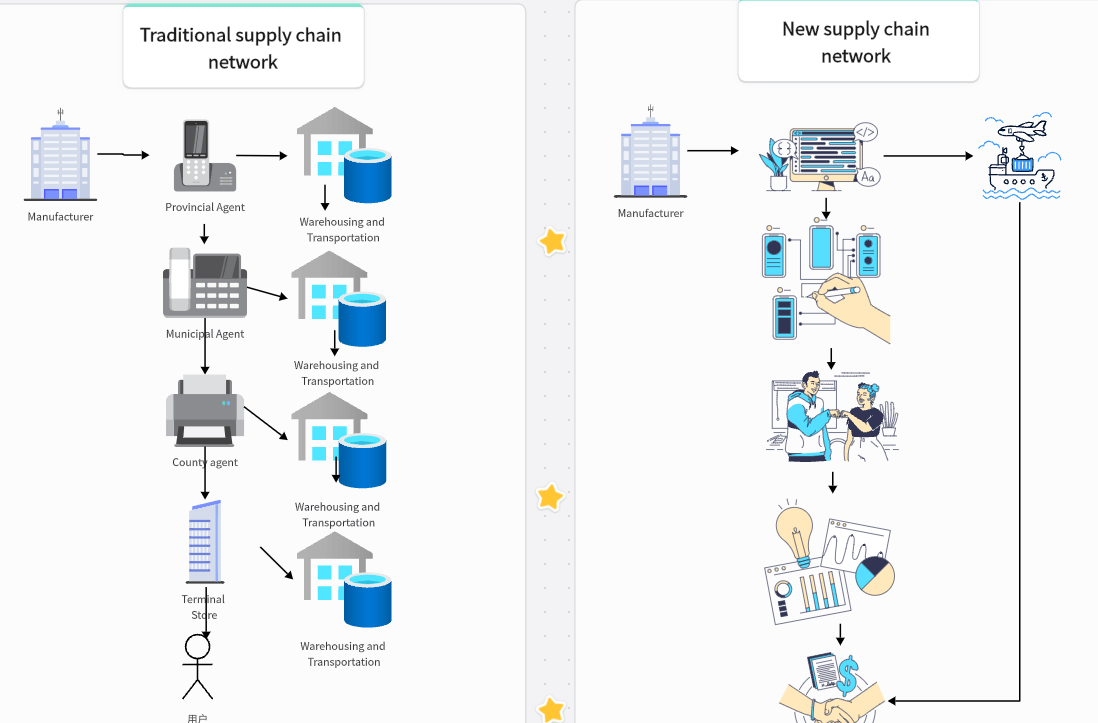
A comparison chart is useful when you need to compare and contrast different concepts or topics.
How to Create:
- List out the topics or concepts you want to compare along the top of the chart.
- Down the side, write the characteristics or categories you are comparing.
- Fill in each box with relevant information for each topic.
Example:
If you're studying different political systems, you can compare "Democracy", "Monarchy", and "Communism" on characteristics like "Leadership", "Economic Structure", "Rights and Freedoms", etc.
Conclusion
Boardmix is a versatile tool that can assist you in creating effective study guides. By harnessing its features and functionalities, you can streamline your study process and enhance your learning experience. Using Boardmix to create your study guides, you can design a learning experience that suits your needs and preferences. Start crafting your own customized study guide today and take a step closer to acing your studies.









